Matador Network's Blog, page 122
September 12, 2024
From the Depths of Our Blue Planet, These Photographers Showcase the Fragility and Beauty of the Ocean

The prestigious Ocean Photographer of the Year contest has once again showcased the breathtaking beauty and fragility of our planet’s oceans. This year’s winner, Rafael Fernández Caballero, impressed with his stunning image of a Bryde’s whale feeding on a baitball. The photograph, selected from over 15,000 submissions, offers a glimpse into the extraordinary underwater world.

Ocean photographer of the year 2024 winner, Rafael Fernández Caballero. Photo: Ocean Photographer of the Year/Rafael Fernández Caballero
Caballero expressed his deep joy and gratitude for the opportunity to witness and capture such a remarkable moment. The win also marked a significant milestone in his career. “This is a dream come true. Spectacular. Being a part of the best compilation of ocean photography this year — and receiving the top recognition — drives me to keep believing in what I do and to continue showcasing the ocean’s wonders,” says Caballero.

Jade Hoksbergen took second place for her photo of a northern gannet diving into the water to catch its prey in the Shetland Islands, Scotland. Photo: Ocean Photographer of the Year/Jade Hoksbergen
Presented by Oceanographic Magazine and Blancpain, the 2024 competition featured a diverse range of captivating images, from dramatic wildlife encounters to poignant reminders of our impact on the marine environment. A baitball being devoured from above and below, eels slithering over rocks at low tide, and a mahi mahi caught with a mouthful of prey were just a few examples of the stunning wildlife showcased in the contest.

Overall third place went to Thien Nguyen Ngoc for their shot of a fishing boat off Hon Yen, Vietnam. Photo: Ocean Photographer of the Year/Thien Nguyen Ngoc
Beyond the awe-inspiring beauty, the photographs highlighted the complex relationship between humans and the ocean. Images of boat crews hauling massive nets, conservationists tending to coral nurseries, and freedivers exploring the depths of blue holes depicted our connection to the marine world.
 Conservation and hope winner, Shane Gross. A green sea turtle is released by a researcher after being caught while trying to catch sharks. Photo: Ocean Photographer of the Year/Shane Gross
Conservation and hope winner, Shane Gross. A green sea turtle is released by a researcher after being caught while trying to catch sharks. Photo: Ocean Photographer of the Year/Shane Gross Conservation and impact winner, Frederik Brogaard. The second biggest whale, the fin whale, lies waiting for its turn to be butchered at a whaling plant in Iceland before getting sent to Japan. Photo: Ocean Photographer of the Year/Frederik Brogaard
Conservation and impact winner, Frederik Brogaard. The second biggest whale, the fin whale, lies waiting for its turn to be butchered at a whaling plant in Iceland before getting sent to Japan. Photo: Ocean Photographer of the Year/Frederik Brogaard Adventure winner, Tobias Friedrich. A scuba diver is dwarfed by a shipwreck in the Bahamas. Photo: Ocean Photographer of the Year/Tobias Friedrich
Adventure winner, Tobias Friedrich. A scuba diver is dwarfed by a shipwreck in the Bahamas. Photo: Ocean Photographer of the Year/Tobias FriedrichThe contest also serves as a reminder of the challenges facing our oceans. Photographs of an octopus sheltering in a plastic bag, a fin whale being hauled ashore for butchering, and a gannet accidentally hanged by its unnatural nest highlighted the devastating consequences of human activities on marine ecosystems.
 Wildlife winner, Manuel Castellanos Raboso. A triumphant mahi-mahi or common dolphinfish proudly displays its catch amidst a feeding frenzy in Baja California Sur. Photo: Ocean Photographer of the Year/Manuel Castellanos Raboso
Wildlife winner, Manuel Castellanos Raboso. A triumphant mahi-mahi or common dolphinfish proudly displays its catch amidst a feeding frenzy in Baja California Sur. Photo: Ocean Photographer of the Year/Manuel Castellanos Raboso Fine art winner, Henley Spiers. Juvenile Munks devil rays are attracted by a green light, seemingly flying through the water in Baja California Sur, Mexico. Photo: Ocean Photographer of the Year/Henley Spiers
Fine art winner, Henley Spiers. Juvenile Munks devil rays are attracted by a green light, seemingly flying through the water in Baja California Sur, Mexico. Photo: Ocean Photographer of the Year/Henley Spiers Human connection winner, Zhang Xiang. A beach reflects the golden haze of the sunset, while a traditional fisherman wades through the water in China. Photo: Ocean Photographer of the Year/Zhang Xiang
Human connection winner, Zhang Xiang. A beach reflects the golden haze of the sunset, while a traditional fisherman wades through the water in China. Photo: Ocean Photographer of the Year/Zhang Xiang“Photography is a powerful ally in ocean exploration and conservation,” says Marc A. Hayek, president and CEO of Blancpain. “We applaud the Ocean Photographer of the Year winners not only for their art but for their help in educating a wider public on the marvels found in the seas.”

Jacob Guy wins the young photographer division for this beautiful image of an algae octopus in North Sulawesi, Indonesia. Photo: Ocean Photographer of the Year/Jacob Guy
If you’d like to view the photographs in person, the 2024 Ocean Photographer of the Year exhibition will make its debut at the Australian National Maritime Museum in Sydney on November 28, followed by additional venues in early 2025. 
The Cheapest and the Most Expensive US Airports to Rent a Car

Renting a car from the airport is a vey convenient way to explore a new city independently, but convenience has a price, and it’s often very high. Once you’ve added the airport fee, the damage insurance, and the liability insurance on top of the price of your rental, you’re often looking at a daily amount that reaches three figures. Car rental companies do vary their prices from one airport to the next, however, and some are significantly cheaper than others.
This fall, CheapCarRental.com compared car rental rates in 100 US airport and ranked them from the cheapest to the most expensive. During the process, they noticed that fall rates (from September 1 to November 31, 2024) were about 28 percent cheaper than summer rates — another good reason to travel during shoulder season.
What’s striking about this survey is the fact that the average price of renting a vehicle from the priciest airport on the list is an impressive 2.3 times more expensive than the renting one from the cheapest airport. The reason behind the price discrepancy isn’t easily explained; there are large, busy, and well-connected airports, as well as smaller airports, on both ends of the ranking.
The 10 cheapest US airports from where to rent this fall a car are:
Raleigh, North Carolina, (RDU) with an average daily rate of $41Bozeman, Montana, (BZN): $42Kahului, Hawaii, (OGG): $45Portland, Oregon (PDX): $45San Juan, Puerto Rico, (SJU): $47Miami, Florida, (MIA): $47Fort Myers, Florida, (RSW): $47Tampa, Florida, (TPA): $47Honolulu, Hawaii, (HNL): $48F. Lauderdale, Florida, (FLL): $48The 10 most expensive US airport where to rent a car are:
Little Rock, Arkansas, (LIT) with an average daily rate of $95Charleston, South Carolina, (CHS): $91Madison, Wisconsin (MAD): $87Reno, Nevada, (RNO): $86St.Petersburg, Florida, (PIE): $86Boise, Idaho (BOI): $85Palm Springs, California, (PSP): $83Colorado Springs, Colorado, (COS): $82San Francisco, California, (SFO): $82Los Angeles, California, (LAX): $80 More like thisTravelTested: How Kyte Is Making the Often Frustrating Car Rental Process More Seamless
More like thisTravelTested: How Kyte Is Making the Often Frustrating Car Rental Process More Seamless
A Utah Ski Resort Is Selling Lift Tickets for Just $19 Per Day

In an era of $200-a-day and up lift tickets at ski resorts throughout the US, one Utah resort is trending in a different direction — at least for a few days this season.
But one resort, sitting in the mountains north of Zion National Park, announced it’s selling $19 lift ticket to celebrate its 60th birthday during the upcoming winter season. Brian Head lift tickets are currently available for as low as $19, covering most of the resort’s early dates, beginning with opening day on Friday, November 8. The resort uses dynamic pricing, automatically raising the prices as demand increases, so it’s best to buy tickets as early as possible to get the lowest rates. Brian Head also announced it invested $1.4 million into on-mountain improvements like new snowmaking equipment, lift accessibility improvements, new lighting for night skiing, and three new downhill trails.
Today, Brian Head has more than 70 trails and eight lifts, as well as the highest base elevation in the state at 9,600 feet above sea level. That makes its snow dry and fluffy, rather than wet and heavy.

Utah is known for cold and powdery snow, but Brian Head’s high elevation makes it especially fluffy. Photo: Brian Head Resort/Jessee Lynch
As of early September, advanced purchase rates at Brian Head range between $19 and $48, but jump to anywhere between $58 and $81 for the period between Christmas break and New Years Day. But rates drop back to $21 and up for dates in January through the end of the season, scheduled for May 4, 2025. Until further notice, skiers who buy tickets online in advance will also get a $10 resort credit per ticket, effectively allowing you to ski for as little as $9 — assuming you would have spent $10 at the resort to begin with.
Brian Head Resort is approximately four hours south of Salt Lake City, making it a bit removed from the crowds of bigger SLC-area resorts like Snowbird, Park City, and Alta. It’s about a 90-minute drive from the airport in St. George, Utah, or three hours from Las Vegas, NV. That makes it ideal for a weekend trip from Salt Lake City or as a stop on a longer point-to-point ski trip through Utah.
View this post on InstagramA post shared by Brian Head Resort (@brianheadresort)
While it’s not among Utah’s largest resorts, which are some of the most popular ski resorts in the United States, Brian Head lift tickets are among the most affordable in the state. Most US resorts use dynamic pricing and offer lower prices for advanced purchase or multi-day tickets. So prices can vary. But as a general estimate, you can expect advanced purchase lift tickets to cost quite a bit more at larger resorts, including Park City (starting at $259 for a single day), Deer Valley (starting at $189 for a single day), and Snowbird (starting at $184 for a single day).
If Brian Head isn’t your vibe, you may want to check out lift ticket costs at some of the smaller resorts owned by Brian Head’s parent company, Mountain Capital Partners. It has some of the lowest-priced ski resorts in the US, including Purgatory in Colorado, where tickets can be as low as $9. 
This Historic Pennsylvania Train Ride Showcases the ‘Holy Grail of Fall Foliage’

There are plenty of amazing leaf-peeping opportunities in the US. A romantic road trip to see the covered bridges of New England is one, taking an air balloon ride to see the foliage from above is another. But the most relaxed and nostalgic way to experience fall in all its glory is by train. There are multiple vintage railroads in the United States that will transport you back in time while you admire the fall colors, but few do it as well as the East Broad Top railroad.

The trains on the East Broad Top railroad are pulled by coal-fired steam locomotives. Photo: Dak Dillon / East Broad Top RR
The East Broad Top railroad was built in 1847 and transported coal until it ceased operation in 1956. The historic railroad, a National Historic Landmark since the mid-1960s, was saved from destruction, restored, and started running again as a tourist attraction in 2021. Since then, you can ride the railroad’s coal-fired steam-engine trains from May until October every year.
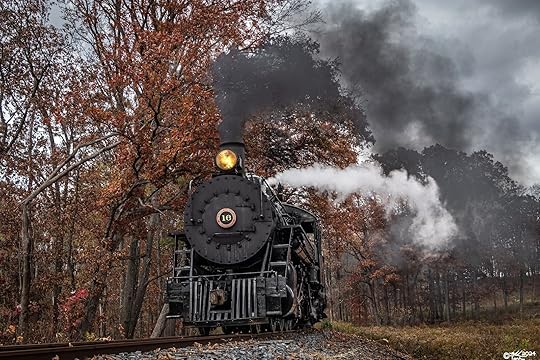
Photo: Mark Turkovich / East Broad Top RR
For the fall season (from September 1 to October 27 in 2024), the East Broad Top railroad operates multiple times per day every Friday, Saturday, and Sunday. The extremely scenic rides last one hour and cover nine miles; starting from the Orbisonia Stations to Colgate Grove, and back. Although it’s a short journey, passengers get treated to what the railroad calls “the Holy Grail of Fall Foliage” while traveling though farmland and along beautiful Aughwick Creek.

Photo: Matthew Malkiewicz / East Broad Top RR
Travelers keen to ride the East Broad Top railroad this fall can choose their own experience. There are three classes of services on board, including open-air cars, enclosed cars, and cabooses, the comfiest way to ride. Traveling in one of the open cars or the enclosed cars costs the same ($22 for adults and $16 for children), but it’s $3 extra to ride in the caboose.

The enclosed cars and the open-air cars on the East Broad Top railroad. Photos: Matthew Malkiewicz / East Broad Top RR
Those with small children may consider booking a ticket for the PEANUTS The Great Pumpkin Patch Express which takes plane during three weekends in October. The experience last 2.5 hours and includes a scenic train ride to the Sincere Pumpkin Patch where children will meet Snoopy and Charlie Brown, pick their pumpkins and decorate them, play games, and more. The special event costs between $30 and $35 for adults and between $24 and $29 for children, depending on the class of service you opt for.
The Great Pumpkin Patch Express which takes plane during three weekends in October. The experience last 2.5 hours and includes a scenic train ride to the Sincere Pumpkin Patch where children will meet Snoopy and Charlie Brown, pick their pumpkins and decorate them, play games, and more. The special event costs between $30 and $35 for adults and between $24 and $29 for children, depending on the class of service you opt for. 

Peanuts: The Great Pumpkin Patch Express event at East Broad Top railroad. Photos: Matthew Malkiewicz / East Broad Top RR
More like thisTravelThe 13 Best Places for Leaf Peeping in United States in 2024This Nashville Hotel Is Steps From the Action and a Retreat From the Noise

Big cities are my Roman Empire. I love staying in the heart of a city, but it can be hard to find hotels that offer a prime location and perfectly blended amenities that suit my travel style. Enter the Hyatt Centric Downtown Nashville.
The boutique hotel opened in 2021, offering a simple elegance with an understated nod to its Music City surroundings. Despite its young age, the Hyatt Centric has quickly become a staple of Nashville’s SoBro neighborhood. Two blocks from Broadway Street, the hotel stands in the heart of the city’s action, surrounded by honky-tonk bars and local landmarks. Yet, within its walls, the Hyatt Centric Downtown Nashville provides a tranquil escape from the lively urban energy.
Nashville had been high on my list of places to visit for a while. After spending a few days exploring the city, using the Hyatt Centric as my home base, it was clear that the city was much more than a checkbox on my travel to-do list.
A short drive from the airport, a quick walk to downtown Nashville
Photo: Hyatt Centric Downtown Nashville
One of the hallmarks of the Hyatt Centric brand is centrally located properties in the heart of popular destinations. Hyatt Centric Downtown Nashville follows this standard to a tee. The drive from Nashville International Airport to the hotel was short, barely allowing enough time to catch my breath or text travel updates to my wife. After a quick zip down the highway, my driver exited onto 2nd Avenue, which quickly led us directly to the hotel’s parking lot and front entrance.
In addition to being close to the airport, Hyatt Centric Downtown Nashville is within walking distance to many of the city’s landmarks, attractions, and culinary hotspots. My flight from Cleveland arrived early in the morning, which gave me a jump on exploring the area. After a quick five-minute walk, I found myself on Lower Broadway, affectionately known as Nashville’s Honky Tonk Highway. The ambiance by daylight contrasts starkly with the scene after dusk, when the neon lights transform the atmosphere into a vibrant, glowing spectacle. After completing the customary hunt for family souvenirs, I headed back to explore more of the hotel.
The rooms at the Hyatt Centric Downtown Nashville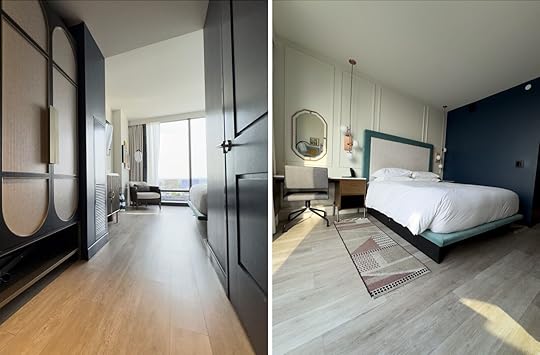
Photo: Kevin Payne
From my first step inside, I knew I was going to love this hotel. The open-air lobby was inviting, with multiple seating areas surrounded by a carefully curated collection of artwork from local artists. To the right was Ella’s, the hotel’s primary dining option.
I made my way up to the 15th floor to check out my digs for the next few days. The room featured a simple yet contemporary design, with floor-to-ceiling windows overlooking the neighborhood and the hotel’s pool. I have relatively simple travel needs but do enjoy spacious accommodations and thoughtful amenities. At 320 square feet, the room offered plenty of space for work and relaxation. It featured a plush king-size bed, a cozy seating area and table, a suitable writing desk, and a stylish wardrobe. My favorite room fixture was the sleek cabinet, which housed a mini-fridge, an in-room safe, and a coffee maker. The cabinet’s interior panels nodded to Nashville legends like Elvis, Dolly Parton, Taylor Swift, and Tim McGraw.

Photo: Hyatt Centric Downtown Nashville
The bathroom featured a large glass shower with a high-pressure shower head, the same one I recently installed in my master bathroom at home. The long marble-top vanity had one sink and ample counter space. Bathrooms at the Hyatt Centric Downtown Nashville come equipped with Bee Kind bath amenities, a countertop vanity mirror, and a Drybar Buttercup hair dryer. Other room amenities included plush bathrobes and slippers.
The Hyatt Centric Downtown Nashville has a wide selection of rooms — 252 guest rooms and 11 suites — including single and double beds and accessible rooms and suites to accommodate every traveler’s needs.

Photo: Kevin Payne
The Presidential Suite is a homerun for families or large groups. It offers luxury amenities like full-size hidden kitchen appliances, a large island and bar seating, a sectional sofa bed, and a handcrafted wooden ping-pong table. Oh, and there’s a stand-up arcade game for extra measure. Plus, the Presidential Suite has a separate bedroom with a king bed and a spacious bathroom with a large walk-in shower and a separate chic bathtub.
Dining at the Hyatt Centric Downtown Nashville and nearby
Photo: Kevin Payne
My early arrival gave me the opportunity to grab breakfast at the hotel before venturing out into downtown Nashville. Ella’s by Christian Petroni is a bright, inviting dining space serving thoughtful brunch favorites in the morning and coastal Italian cuisine for lunch and dinner.
Formerly known as Ella’s on 2nd, the restaurant now features a revamped menu thanks to a recent partnership with Food Network star Christian Petroni and Red Pebbles Hospitality. The space features an open kitchen, giving diners a bird’s-eye view of the culinary staff in action. Ella’s also features a spacious, inviting cocktail bar and seating area, perfect for pre-dinner beverages or networking.
The ricotta pancakes with maple butter were light yet packed with flavor. They were good enough to become a staple each morning I spent at Ella’s. In addition to a list of entrees, Ella’s brunch menu includes appropriate cocktails and a selection of bakery items, including cornetti (Italian croissant-like pastries), scones, and Nutella pizza bread.

Photo: Kevin Payne
For my lone dinner at Ella’s, I enjoyed an assortment of starters from the menu, including the best housemade mozzarella sticks I’ve ever had. The fried meatballs, shrimp scampi, and fire-roasted carrots were equally delicious, as was the Margherita pizza, which I watched being tossed and prepared. It’s hard to go wrong with a steak, so I opted for the New York Strip as my entree, which was perfectly prepared. Although I didn’t dine at Ella’s for lunch, the restaurant serves some dinner entrees plus a few sandwiches.
The hotel’s other culinary offering is Lala’s, a rooftop pool bar and restaurant on the ninth floor. Unfortunately, due to rainy skies, Lala’s was not open during my stay. The popular gathering spot features limited hours and a small, curated menu. Beverage selections include wines, ciders and seltzers, draft and canned beers, craft cocktails, and frozen drinks.
In-room dining is also available from morning until late night seven days a week for hotel guests.
Next door to the Hyatt Centric is Nashville staple The Pancake Pantry, which has been serving up breakfast classics since 1961. Its expansive menu includes nearly 20 types of pancakes and other delicious bites to start your day. I’ve been on a not-always-strict health kick lately, so I opted for gluten-free buttermilk pancakes. Outside of placing my order, I forgot they were gluten-free, a testament to the restaurant’s expertise in perfecting the art of pancakes. If you’re thinking of visiting The Pancake Pantry, be sure to arrive early to avoid the long line that frequently extends around the block.

Photo: Kevin Payne
It’s not necessarily a requirement when visiting Nashville, but I couldn’t leave the city without sampling some hot chicken. Prince’s Hot Chicken is considered to be the birthplace of the spicy delight, with dozens of local restaurants staking their claim for the best birds in town. The closest location on Broadway is less than a half-mile from the hotel, where you’ll also find a Hattie B’s. With a history only dating back to 2012, Hattie B’s is a relative newcomer in the hot chicken game compared to other hot spots. But what it lacks in history, it makes up for in flavor.
The menu features a collection of chicken dishes and ridiculously good sides. My favorite was the Dirty Bird Fries, a basket of piping hot crinkle-cut fries, pimento mac and cheese, chicken tender bites, and comeback sauce. Hattie B’s chicken comes in six heat levels ranging from Souther (no heat) to Shut The Cluck Up. I’m no spice king, so I opted for a medium chicken sandwich, which turned out to be the perfect level for me.
Of course, curiosity got the best of me, and I asked the manager if I could sample the hottest chicken. He obliged, delivering a small sampling of spicy tenders with a nearly indescribable reddish-brown exterior that both delighted and frightened me. It was the hottest thing I’ve ever tasted, with a sting that lingered long after I left. For spice fans, though, it may not be as bad.
A short walk from Hyatt Centric stands the River House, a stylish upscale restaurant with a business casual dress code. The restaurant’s menu features a collection of seafood, sushi, steaks, and chops. I enjoyed The Hemingway, a center-cut filet mignon covered in cognac cream. The River House’s interior is as elegant as its food, a sharp contrast to the Honky Tonk bars located blocks away.
Modern amenities with a personal touch at the Hyatt Centric Downtown Nashville
Photo: Hyatt Centric Downtown Nashville
The hotel is a bright, beautiful space with as much charm as the city itself. A stop on the ninth floor leads to one of Hyatt Centric Downtown Nashville’s central hubs of activity. On one half of the floor, you’ll find a collection of rooms and spaces for meetings, conferences, and other events. On the other half sits the hotel’s pool and rooftop bar and a 24-hour fitness center.
The rooftop pool looked so inviting looking down from my hotel room window despite the rain. Pristine white lounge chairs line both sides of the pool, with umbrellas on one side for those who enjoy the shade. There are also three in-pool chaise lounge chairs at one end of the pool so you can catch some rays while taking a dip in the crystal-clear water.
The blue-and-white-striped hallway leading past the pool features playful swimming-themed artwork, restrooms for guests, and a water bottle refilling station.
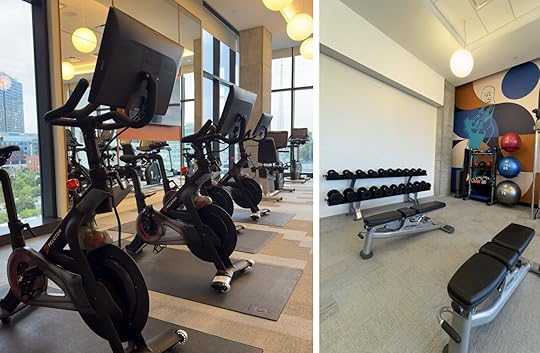
Photo: Kevin Payne
Behind the large glass doors at the end of the hall sits one of the largest hotel fitness centers I’ve experienced. As you enter, you’ll find towels for guests to use during workouts and a mini-fridge filled with complimentary ice-cold bottled water. On the counter lie cards with a map of the surrounding area and directions for suggested running routes from the hotel. They featured a scannable QR code to access the map from your mobile device.
As I walked past the counter, I was captivated by what was undoubtedly the building’s most striking piece of art — a colossal mural of Dolly Parton riding a Peloton.
The fitness center is open 24 hours a day and features an array of exercise equipment for guests to use, including free weights, kettlebells, medicine balls, exercise balls, bands, mats, and foam rollers. The opposite end of the space showcases floor-to-ceiling windows yielding neighborhood views, lined with ellipticals, treadmills, and Peloton bikes. There’s also plenty of open space to use for yoga, stretching, and recovery.
Things to do in Nashville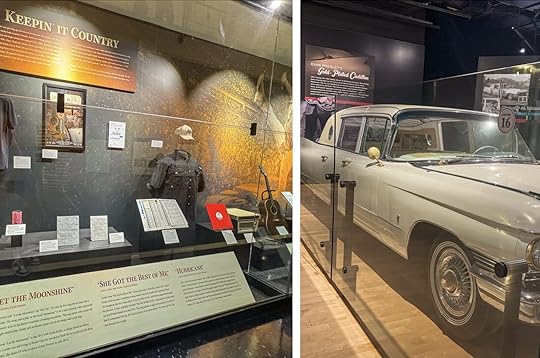
Photo: Kevin Payne
During my stay, I had several opportunities to explore downtown Nashville. The city has become an instant favorite of mine, and I’ll return to it soon with my family. The hotel’s prime location places you within easy reach of Nashville’s cherished attractions, including the honky-tonk-lined Broadway Street, diverse shopping, dining, and a wealth of entertainment options.
The Country Music Hall of Fame is well worth a visit, even if you aren’t a huge fan of the genre. The museum features a perfect blend of tributes to country music pioneers and legends while tipping its hat to modern artists.

Photo: Kevin Payne
I spent considerable time at Fifth and Broadway. Located across from Bridgestone Arena, the complex features a collection of retailers, restaurants, and Nashville’s largest food hall. Besides my spice-filled adventure at Hattie B’s, I also indulged in an assortment of tacos at Velvet Taco, located in the Assembly Food Hall. As a donut enthusiast, I couldn’t resist visiting Tennessee’s Five Daughters Bakery to sample its famed Hundred Layer Donuts. The bakery’s Chocolate Sea Salt Hundred Layer Donut is exceptional, truly in a league of its own. Also located in the complex National Museum of African American Music, where I could’ve spent hours immersed in the museum’s interactive exhibits.
Across the street from Fifth and Broadway stands the famed Ryman Auditorium, a musical landmark with a history spanning over 130 years. I loved touring the iconic venue, including looking out over the hallowed auditorium for a complimentary on-stage photo opportunity.
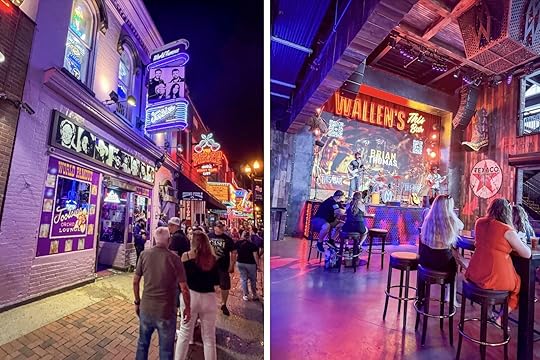
Photo: Kevin Payne
On my last night, I took one last venture down Broadway to soak in as much live music as possible. The first stop was the world-famous Tootsie’s Orchid Lounge, which offers three floors of bars, dining, and live music. My night ended with a quick stop at Morgan Wallen’s This Bar, one of the newest bars and restaurants on Lower Broadway. Just off the main drag, it’s one of the many bars and honky tonks owned by country music stars and other famous musicians, including Luke Bryan, Miranda Lambert, Kid Rock, and Jon Bon Jovi. 
Experience Liverpool’s Music History With a Stay at the Club Where the Beatles Played Some of Their First Gigs

The Casbah Coffee Club, a cultural landmark for Beatles fans in Liverpool, England, has recently opened its doors to Airbnb guests. It’s here, in this basement of this home, where The Beatles played some of their earliest gigs.
We hope you love the Airbnb we recommend! Just so you know, Matador may collect a small commission from the links on this page if you decide to book a stay. Listed prices are accurate as of the time of publication.
The Airbnb is hosted by Pete Best, the band’s one-time drummer, and his brother Roag, who lived in the house as teenagers. The house was originally owned by the bother’s mother, Mona Best who transformed the property’s cellar into the music venue, Casbah Coffee Club in 1959. The club quickly became a go-to for local musicians, providing a platform for emerging talent. Its intimate atmosphere and unpretentious charm made it an ideal venue for bands to hone their craft and connect with a dedicated audience.

Photo: Airbnb
After providing a stage for the Beatles for over 40 performances, the band played their final gig here on the club’s closing night in 1962. The British government granted the historic venue protected heritage status in 2006 and reopened its doors to the public as a tourist attraction.
“I think it’s a good idea to let people know about the Casbah,” says Sir Paul McCartney on the club’s site. “The Casbah was the place where all that started. We helped paint it and stuff. We looked upon it as our personal club.”

Photo: Airbnb
Today, visitors have the opportunity to stay in the very place where the legendary band began their musical journey. The Airbnb has posters, guitars, photographs, and other Beatles-themed items throughout, with rooms named after band members.
 Photo: Airbnb
Photo: Airbnb Photo: Airbnb
Photo: AirbnbThe McCartney Suite sleeps up to two people and includes access to a living area and a fully equipped kitchen. You can enjoy the club’s original features, such as the exposed brick walls and the stage where The Beatles once performed. The nightly rate of around $195 gives you access to the club’s museum, allowing you to delve deeper into the venue’s history. 
Camera Roll: Scenes From the Colorful Züglete Cow Festival in Gstaad, Switzerland

Every autumn, as the lush alpine meadows begin their slow turn toward winter, the small Swiss village of Gstaad plays host to a centuries-old tradition known as the Züglete. It’s a tradition deeply rooted in the village’s history, marking the seasonal migration of cattle from their high-elevation summer pastures down to year-round barns in Gstaad’s Saanen Valley. For those who live in Gstaad and its surrounding farms, it’s a moment of pride and celebration. For visitors, it offers a way to connect with pastoral life — and enjoy a bit of Swiss culture, plus some great cheese.
The word “Züglete” roughly translates to “procession” or “move” in Swiss-German, which is what it is: a slow parade of cows and their herders through the streets. It happens in several small villages throughout Switzerland in early fall. The cows, adorned in flower crowns, are celebrated by spectators as they sport traditional, oversized bells. On the morning of the Züglete, the sounds of cowbells started echoing through Gstaad as the herders, dressed in traditional Swiss attire, begin the long trek down the steep paths from the mountains; I could hear it from my hotel room by 8 AM. In town, vendors set up tables selling homemade crafts and snacks, markets and cafes are packed with locals and visitors alike, and traditional singers and musicians take the metaphorical stage between each bovine procession.
View this post on Instagram
A post shared by Suzie Dundas (@hikeupyourskirt)
There was something quietly profound about the Züglete, especially in a place like Gstaad, often associated with luxury tourism and Chanel and Prada stores. It was almost funny to see cows, goats, dogs, and traditionally dressed farmers parade down the street directly in front of the glamorous designer boutiques, seemingly highlighting the fact that Gstaad is still, at heart, a farming town.
The tradition has been going on for centuries, but about a decade ago, the tourism board decided to organize the individual cow processions and parades into one bigger, more organized celebration. It’s usually held on the last Saturday of August and is free to attend. It’s lively, colorful, and exciting, with a noticeable energy running through the crowd when viewers get a glimpse of the next round of cows entering the village.
I was lucky enough to attend the 2024 Gstaad Züglete, and found time to take a few photos when I wasn’t admiring the many friendly dogs in attendance, tasting cheeses and Swiss wine, or browsing the local crafts (and high-end chocolate) available from throughout Switzerland.

Roughly 10 farming families participate in the Zülete, but there are several dozen farmers around Gstaad who bring their cows to lower pastures at some point in early fall. The large bells are just for the parade, and will likely be hung outside the barns once the cows arrive. When you see the large bells hanging on a barn or farmhouse, you’ll know the cows have already arrived for the season. Photo: Suzie Dundas

Gstaad is never very busy in the summer, with the exception of the weekend of the Züglete. Locals and out-of-town visitors alike come to celebrate both the cows and the end of summer in the mountains. It can be one of the busiest weekends of the year in Gstaad. Photo: Suzie Dundas

Alpenhorning is a long-standing tradition in Gstaad, Switzerland, deeply rooted in the pastoral culture of the Swiss Alps. The alpenhorn, or alphorn, has long been associated with Swiss Alpine regions, as its distinctive, resonant sound was traditionally used to communicate across mountain valleys. Over time, alpenhorning has evolved from a practical tool into a cultural tradition and is often played at Swiss festivals and events. The instrument itself is typically handmade from spruce wood and can be up to nine feet long. This is Alphorngruppe Gstaad, the town’s local alpenhorning band. Photo: Suzie Dundas

Saanenbrätzeli are a traditional pastry from the Saanenland region of Switzerland, particularly from the town of Saanen (about 1.5 miles from Gstaad). They’re shaped like tubes and have a hard, crunchy texture, more akin to a cracker. They have a subtle sweetness and rich buttery flavor, thanks to being made with local butter. Saanenbrätzeli are usually sold served at festivals, special occasions, and celebrations in the region, symbolizing the area’s culinary heritage. Many local bakeries and families still use traditional recipes passed down through generations to make the beloved pastry, preserving its cultural significance in Swiss Alpine food traditions. At the Gstaad Züglete, several vendors were selling their own homemade versions. Photo: Suzie Dundas

Flower crowns are a significant part of the Gstaad Züglete as a way to celebrate and honor the cows and show how much the farmer value them. Each farming family makes their own crowns from local wildflowers, symbolizing the connection between the animals, the land, and the changing seasons. They also add to the festive atmosphere of the Züglete, as you’ll find flowers on vendor tables, performers outfits, and outside many shops and storefronts. These cows belong to the Johann von Grünigen family, known for making some of the most ornate crowns in the festival. The base for the crowns are the one-legged stools farmers use while milking the cows. Photo: Suzie

Food is a huge part of the Züglete festival, with booths selling cheese and breads, busy sidewalk cafes, outdoor wine tastings, and opportunities to buy and try waffles, chocolate, and just about every other Swiss treat you can think of. I’d recommending picking up a kit to make fondue or raclette at home; it doesn’t get much more “shop local” than when you can buy cheese as the cows it came from walk by. Photo: Suzie Dundas

The oversized bells worn by cows in the Züglete are called “treicheln” or “glocken.” The bells help farmers find their grazing cows in the vast and often foggy mountain pastures. The distinct sound of the bells guides herders to their cattle, making it easier to manage them over large distances in the rugged Alpine terrain. In modern times, the bells have become a significant part of the visual and auditory experience of the Züglete, preserving a deep-rooted connection to the region’s bygone traditions. The bells worn by cows on most days are much smaller, but the big bells come out to celebrate the Züglete. If you’re in Gstaad around late August, you’re likely to hear them any time you’re outside. Photo: Suzie Dundas

Cheese is an essential part of Switzerland’s food culture, and the cows who parade through the streets during the Züglete are the same cows used to make the region’s famous alpenkäse, or alpine cheese. Other types of cheese made in the area include Gruyère (actual Gruyère, from the town of Gruyère) and Emmental, among many others. Numerous vendors sell all types of locally made Gstaad cheese at the Züglete, and yes, samples are almost always available. Photo: Suzie Dundas

The cows are adorable, and many farmers say the older cows get excited when they see the bells and flower crowns come out. However, this cow is just hot. It was a warm day when the cows paraded through the village, and many stopped at the public oversized fountains in town to grab a drink before they continued to their winter barns. Photo: Suzie Dundas

Three cheers for the unsung heroes of the parade. Now you know how to say “cow dung” in German. Photo: Suzie Dundas
More like thisAdventure TravelYou Can Drive in a Real-Life Mario Kart Race on a Swiss MountainApple’s New IPhone 16 Is a Game Changer For People Who Love to Travel

It’s hard to imagine how we traveled in the age of flip phones. How did we navigate new cities, find hole-in-the-wall bars, or where to go for the best slice? Although getting away from screens on vacation should be mandatory, we rely heavily on the tech in our pocket. And it’s about to get even more helpful. This week, Apple announced it will be introducing generative AI to the newest iPhone models, and some of these upgrades and features will make life easier for travelers. From asking AI about locations at the click of a button to getting Siri to sort your itinerary for you, Apple Intelligence could be your new travel companion.

Photo: Apple
The next generation of iPhones will include a new camera button located on the right side of the device below the power button. This addition has a slew of new uses within the camera app and can also activate the new AI camera features.
Users can point, click, and hold the camera button to get information on a restaurant, such as opening hours and ratings, options to view the menu, and even make a reservation. Or, say you’re passing a flyer for an event; you’ll be able to use the camera and seamlessly add the details to your calendar. Visual intelligence will allow you to get information on pretty much anything you see, from breeds of dogs and types of plants to what model of push bike you’re looking at and where you can buy it.

Photo: Apple
Apple has also stated that with the first set of Apple Intelligence features, Siri will become more natural, contextually relevant, personal, and deeply integrated into the system experience. With upcoming updates, users will be able to do things like ask Siri for details on a flight they have booked. Siri will be able to cross-reference flight information from an email or text with real-time flight tracking information to provide up-to-date arrival times. You’ll also be able to ask Siri to show photos from a specific trip or find plans for a lunch reservation you made through text…and then tell you how long it will take to get there.
And there’s more. Here are a few other notable changes Apple will be rolling out that will help with travel.

Photo: Apple
Priority notifications: AI should prioritize notifications such as a boarding pass or upcoming appointments.
Better cameras: The cameras have been upgraded, and the native camera app has much more flexibility and creative editing functions.
Reduced background noise when taking videos: This breakthrough will enable you to capture clearer, more immersive footage, even in windy conditions.
Industry-leading durability: Ideal for outdoor enthusiasts, the new devices will feature robust construction, strong back glass, water—and dust-resistant properties, and regular software updates. The Ceramic Shield is also 50 percent tougher than its predecessor and twice as resistant to shattering as glass found on other smartphones.
Enhanced connectivity for adventurous travelers: Leveraging the same advanced technology as Emergency SOS via satellite, users will be able to send and receive texts, emoji, and Tapbacks over iMessage and SMS while venturing beyond cellular and WiFi coverage. And the addition of Emergency SOS Live Video will enable users to share live video footage or photos with emergency dispatchers during an emergency call, providing valuable context for a swift response, even in the most remote spots.
With the announcement that Apple is utilizing AI, there have been growing concerns over privacy and data sharing. The company has sought to address this, the best they can.
Apple states that many of the models run Apple Intelligence entirely on a device, and to run more complex requests that require more processing power, they use something called Private Cloud Compute. When using Private Cloud Compute, users’ data is never stored or shared with Apple and is only used to fulfil requests. Users who choose to access ChatGPT will have their IP addresses obscured, and OpenAI will not store their requests.
All in all, this should mean a safe user experience with privacy at every step for those who want to use AI to help them explore the world. 
The Ritz-Carlton Bachelor Gulch Strikes an Ideal Balance of Secluded, Social, and Spirited

Stepping into The Ritz-Carlton, Bachelor Gulch in Beaver Creek, Colorado, just outside of Vail, feels like entering a cozy alpine oasis. is tucked into the mountain up on a perch among the majestic Rocky Mountains, peering down to showcase the scenic beauty of the Vail Valley. The property, with rooms from around $1,000 during ski season and far less during shoulder seasons, looks – and feels – like something straight out of a sophisticated Swiss postcard, albeit with Colorado’s rugged Wild West spirit.
The property just finished a multi-million dollar refresh in 2022 in honor of its 20th anniversary, encompassing a complete transformation of the rooms, dining outposts, and more, on-site.
We hope you love the Ritz-Carlton, Bachelor Gulch! Just so you know, Matador may collect a small commission from the links on this page if you decide to book a stay. Listed prices are accurate as of the time of publication.
Dining and drinking at the Ritz Carlton, Bachelor Gulch
Traveling to Colorado? Check out Matador’s Colorado accommodation guides to the best places to stay across the state: 11 unique Airbnb Colorado rental homes for your next group getaway 10 Airbnb Estes Park rentals near Rocky Mountain National Park These Denver airport hotels put you close to the terminal with luxe amenities The best Airbnbs in Denver for beer, 420, and mountain culture Vail Airbnbs that make you feel like you’re in the heart of Bavaria Aspen Airbnbs to chill like a celebrity Stay near Garden of the Gods and Pikes Peak at these Colorado Springs Airbnbs These Airbnbs Near Telluride Offer an Authentic Mountain Getaway 10 boutique, luxurious, and trendy Denver hotels

Photo courtesy Ritz Carlton Bachelor Gulch
The Ritz, as you’ll hear staff and regulars call it, is the kind of property you’d never have to leave if you don’t want to (and it sure is hard to leave, when it’s time to check out). There are more than a half dozen dining outlets on-site to try, ranging from world-class sushi to Michelin-recommended flavors, an adorable coffee shop and market space, and The Great Room, which is right off the lobby, and gives off those luxe Wild West mountain cabin vibes that Avon and adjacent Beaver Creek are known for. Here, I admired the snug feeling of the wood and leather furnishings, the three-story wood-burning fireplace, and the abundance of tasty drinks and appetizers that were served around me.
No guest should miss dining at WYLD, the property’s signature restaurant, which serves a sophisticated menu of dishes and craft cocktails—including steak, fish, and fresh garden fare, using the “bold cooking techniques” that have drawn critics and connoisseurs from around the world to this property. The menu focuses on showcasing seasonal flavors and sourcing as locally as possible which, during Colorado’s high-altitude growing season of summer and autumn, means a lot of veggies and meats sourced from along the I-70 corridor.
On-site amenities
Photo courtesy Ritz Carlton Bachelor Gulch
The ski-in, ski-out access in winter is unparalleled – the Bachelor Gulch Express high-speed quad chairlift is located in this property’s backyard, just steps from the lobby lounge area. The access to hiking and biking trails surrounding the property make it feel like an outdoor playground in every other season. There’s even a Ski Concierge service in the winter for guests to arrange rentals, boot fittings, ski storage, and anything else they need to get on the slopes.
In the summer, guests can access multiple tennis courts and golf courses. The resort is surrounded by several celebrated Vail Valley golf courses (and although I’m not a golfer, I’ve been told that during the warmer months, the hotel offers fabulous Beaver Creek golf packages). A year-round heated pool and multiple outdoor jacuzzis are next to the quaint patio area, dotted with an abundant number of heaters and a fire pit to gather around on a brisk evening.
There was a sort of backyard space right behind the property adjacent to the pool and Fireside Bar with lawn games like cornhole, horseshoes, and archery. My dog loved exploring this outdoor space and meeting the other Fido friends spending time with their human families.
And even though it was August when I spent the night, I could feel the echoes of merriment in winter’s past, knowing the resort’s backyard space with its “Fireside Bar” dining area can be a very boisterous place to gather and relax after a day of snow sports.
Healing on-site wellness amenities at the Ritz-Carlton, Bachelor Gulch Spa
Photo courtesy Ritz Carlton Bachelor Gulch
The 21,000-square-foot spa at the Ritz-Carlton, Bachelor Gulch feels like a comfy refuge tucked into the mountain. It’s on the third floor and boasts 19 different treatment rooms. Visitors can explore a range of signature treatments aimed at healing the soreness that can come from an active day of outdoor adventures like hiking or skiing. Each offering uses locally sourced herbs, plants, and minerals—even activated charcoal obtained from Colorado mines.
The spacious and clean fitness center is open 24 hours a day, with an inspiring view of the mountains. There’s a wide range of cardio machines and weights, so visitors will never have to worry about waiting on specific equipment. Guests can also sign up for one of the property’s personalized wellness programs, including personal training and group exercise classes like yoga and mat Pilates classes.
Guest rooms at the Ritz-Carlton, Bachelor GulchRooms at the Ritz-Carlton, Bachelor Gulch feel comfortable and welcoming, with traditional mountain lodge elements such as working stone fireplaces, plenty of mirrors that create a larger-feeling space, and sliding glass doors that may lead to a balcony with clean, fresh mountain air.
Guest room design aims to “bring the feeling of the earth indoors,” with touches like natural wooden tones and naturally inspired art that evokes the same sense of wonder you get from staring out onto a mountain landscape. The large, marble-accented bathroom features a separate shower area and an oversized soaking tub to soothe sore muscles after a day on the mountain. I spent the night in a standard king room that was dog-friendly (and bringing my pup added eons of joy to the experience I had at the hotel — but more on that later).
Special eventsEvery visit to this hotel will be a different experience due to the extensive programming that rotates depending on the season. During the holidays, a festive mood and activities like visits with Santa and s’mores add a touch of magic.
For example, from October 4 to 6 this year, photography fans can sign up for a special program led by acclaimed National Geographic nature photographer Jad Davenport. This annual Fall Photography Workshop goes beyond teaching basic photography skills and focuses on visual storytelling set against the backdrop of Colorado’s stunning fall foliage.
Getting around town
Photo: Kristi Blokhin /Shutterstock
Having a personal vehicle definitely makes it easier to get around this sprawling mountain village and Avon, the nearby town center, but for those who’d rather not drive, the public transportation is solid. Complimentary transportation to Beaver Creek Village is available through the Village Connect app and hotel staff can also assist guests in arranging private transportation to and from Denver International Airport or Eagle County Regional Airport or around the Vail Valley.
Overall ambianceFrom my travels, I’ve learned that it’s the little details about the decor on-site and the welcoming attitude of the staff that make a visit to a hotel special, and the Ritz-Carlton Bachelor Gulch excels in this regard. I could tell how family-friendly the property was, too (even though I only brought my pup), seeing plenty of kiddos having the time of their lives exploring the complex and the adjacent trails.
From the ability to order a locally made microbrew at the bar, to the beauty of the enormous flower arrangement I encountered in the lobby on-site (it was seriously the largest, most boisterous collection of sunflowers I’ve ever seen—almost like there was a garden right inside the lobby), these little touches enhanced the experience.
Pet friendlinessI brought my dog with me on this trip—and after our first hour on-site it felt like each employee seemed to remember us (and even remembered my pup’s name). Pets are welcome here with a limit of two dogs per room for $150 per stay cleaning fee plus a $30 per night pet fee. And with the way my Shiba Inu fur baby sheds all over every room, I’m not surprised the hotel implements this cleaning fee.
The Ritz-Carlton, Bachelor Gulchl is a great place to stay if you’re seeking somewhere quiet and secluded—but still close to adventure. This hotel is just a 15-20 minute drive to downtown Vail, and a few minutes away from downtown Avon. Bus service is frequent and reliable throughout the valley.
I felt isolated enough that it was a very relaxing stay, but we were still close enough to the local mountain adventures (hiking trails beginning right out of the property’s “backyard”) that I wouldn’t have needed to leave the property if I didn’t want to. Whether you’re coming in summer, winter fall, or in the spring—it’s bound to be a luxurious and comfortable visit. 
September 11, 2024
Travelers Could Soon Have to Pay a Fee to See One of Rome’s Most Famous Monuments

Rome is looking for a way to manage the crowds at the Trevi Fountain, one of the most popular tourist attractions in the Italian capital and the most famous fountain in the world. A fee-based reservation system might be the solution.
The Trevi Fountain has been victim of its success for many years, with hordes of tourists visiting it daily in an attempt to see the immense 18th-century structure and toss a coin in its basin, as per tradition.
In 2019, new municipal regulations forbade bathing in the fountain, lying on its edge, and climbing it, among other restrictions, in order to protect the monument. Eating food around the fountain is also currently prohibited but the rule isn’t strictly enforced.
To improve the visitor experience and the quality of life for local residents, Alessandro Onorato, deputy mayor of tourism for Rome, wants to put an end to the overcrowding and disorderly conduct (including fights) that takes place around the Trevi Fountain by introducing a new entry system.
View this post on InstagramA post shared by Alessandro Onorato (@alessandro_onorato)
While the space around the fountain, including the Piazza di Trevi in front of it and the streets surrounding it, would remain accessible to all at all times, the area that is located down the stairs from the piazza and is closest to the basin would require a reservation-only ticket.
Onorato hopes that a reservation system would help regulate the flow of visitors. The ticket would cost €2 ($2.20) and allow for a 30-minute visit. Locals would be exempt from this modest fee.
According to Onorato, “The proceeds would be reinvested for the protection of the monument and to hire staff who would guarantee safety and manage the flow of tourists, creating new jobs.”
Rome is not the only Italian city trying to regulate crowds with entry fees. In April, 2024, Venice launched a limited-time Access Fee of €5 ($5.50) for day-trippers wanting to visit on certain dates. The scheme covered a period of 29 days and netted 2.5 million euros for the city.
Earlier this year, the authorities in Seville, Spain, the third most-visited city in the country, explained they wanted to introduce an entry fee to the magnificent Plaza de Espana square in order to limit crowds and provide funds to converse the structure.
Amsterdam is another European city attempting to fight overtourism and improve the quality of life for its residents with multiple drastic measures, including limiting short-term rentals and cruises, banning tourist-focused stores, and increasing its tourist tax. 
Matador Network's Blog
- Matador Network's profile
- 6 followers



